Trademarking Signs with "China" or "National" in China
Posted on Thursday, June 30, 2011
On August 19, 2010 China's State Administration for Industry & Commerce issued the "Examination Standards for Trademarks Containing "China" and "National" as the First Word" specifically referencing provisions 1, 2, 3, 7, 8 of Article 10 and provision 1 and 3 of Article 11 of China's Trademark Law. The Articles are listed below (in blue) and include a more detailed explanation or interpretation of the listed provisions.
Article 10 of China Trademark law states that the following signs shall not be used as trademarks:
(1) those identical with or similar to the State name, national flag, national emblem, military flag, or decorations, of the People's Republic of China, with names of the places where the Central and State organs are located, or with the names and designs of landmark buildings;
Explanation:
A sign that bears any similarity to the State name, even in abbreviated or contracted form, both in English (such as CN, CHN, P.R.C., China or PR of China, etc...) or Chinese, will be rejected. The same applies to signs with similarities to China's national flag (red with five yellow stars); emblem (circular in shape, with grain-borders and featuring Tiananmen gate under the five stars); military flag, (the flag of the People's Liberation Army consisting of a single yellow star and the Chinese characters for "8" and "1" on a red background); and "decorations", which refers to any medals or decorations awarded by China's government to individuals or organizations who have contributed to the State or society. Finally, similarities to places with Central and State organs or landmark buildings, including Tiananmen Square, Xinhua Gate, the Great Hall and so on, is prohibited.
(2) those identical with or similar to the State names, national flags, national emblems or military flags of foreign countries, except that the foreign state government agrees otherwise on the use;
Explanation:
Using the name of any country, in Chinese, English or the original language, in a trademark, such as "France Bags", is prohibited. Agreement on use from the foreign government must be in written form. A successful trademark application in its "native" country is considered agreement/approval from the government.
(3) those identical with or similar to the names, flags or emblems or names, of international intergovernmentaI organizations, except that the organizations agree otherwise on the use or that it is not easy for the use to mislead the public;
Explanation:
Examples include the United Nations, European Union, World Trade Organization and so on, inclusive of full names, as well as abbreviated or contracted forms.
(4) those identical with or similar to official signs and hallmarks, showing official control or warranty by them, except that the use thereof is otherwise authorized;
(5) those identical with or similar to the symbols, or names, of the Red Cross or the Red Crescent;
(6) those having the nature of discrimination against any nationality;
(7) those having the nature of exaggeration and fraud in advertising goods;
Explanation:
Any sign that overly-expresses the characteristics or the quality of the goods or services, and easily causes the public to misinterpret the characteristics or quality of the goods or services is prohibited. For example, trademarks such as "National Liquor" white wine or "Ultimate" mineral water, etc., are not allowed.
(8) those detrimental to socialist morals or customs, or having other unhealthy influences.
Explanation:
"Socialist Morals" refers to the generally accepted standard behavior and norms of the Chinese people, as well as the positive customs and habits in a certain period of time. "Unhealthy influences" are when the text, graphics or other elements of the trademark adversely affect China's political, economic, cultural, religious, ethnic and other social and public interests and public order.
The geographical names as the administrative divisions at or above the county level and the foreign geographical names well known to the public shall not be used as trademarks, but such geographical terms as have otherwise meanings or are a part of collective marks/or a certification marks shall be exclusive. Where a trademark using any of the above-mentioned geographical names has been approved and registered, it shall continue to be valid.
Furthermore, Article 11 states that the following signs shall not be registered as trademarks:
(1) those only comprising generic names, designs or models of the goods in respect of which the trademarks are used;
Explanation:
This refers to signs that are similar to China' standards, industry standards, or conventional names, graphics or shapes. Full names, acronyms, abbreviations and common nicknames are included. Examples include as China's "502 glue", "Korea White Ginseng", and "S" clothing.
(2) those having direct reference to the quality, main raw materials, function, use, weight, quantity or other features of the goods in respect of which the trademarks are used; and
(3) those lacking distinctive features.
The signs under the preceding paragraphs may be registered as trademarks where they have acquired the distinctive features through use and become readily identifiable.
Explanation:
Simple lines, common geometric shapes, or unembellished combinations of letters (for example, "C" Clothing).
In addition to pointing out the provisions, the Standards further clarified the reasoning behind examinations:
1. Trademark applications comprised of, or containing the terms "'National' + name of good" will be rejected due to "constituting exaggeration and fraud", "lack of distinctive features" and/or "having adverse impact".
2. Trademark applications with "National" as the first word, but without the "'National' + name of good" combination, will be treated differently and rejected due to its harm to fair competitiveness, fraud or negative political influence.
So if a trademark application with "China" or "National" in the sign does not contradict any of the above provisions, can it be trademarked? Not quite yet. The applicant must also satisfy the following conditions:
- The applicant's qualifications must be approved by the State Council or a competent authority. The applicant's (company) name must be the same as the name on the trademark registration information.
- The trademark must be identical to the applicant's (company) name or its abbreviated version, which must have also been approved by the State Council or a competent authority.
- The trademark and the applicant must have close corresponding relationship.
- The scope of the goods or services referred to by the applied trademark must be consistent with the approved business scope of the applicant (his/her business).
Although China's Trademark Law contains hints of socialism, the Law itself shows development on par with those of other countries. After all, the purpose of trademarks is to prevent confusion between domestic or international names, or create false, exaggerated assumptions. These are the basic tenets of trademarks that every country must have.
Read more...



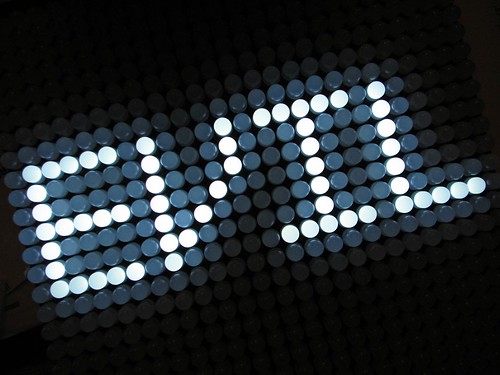
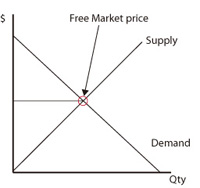
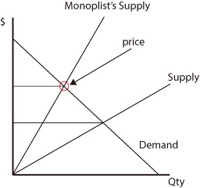
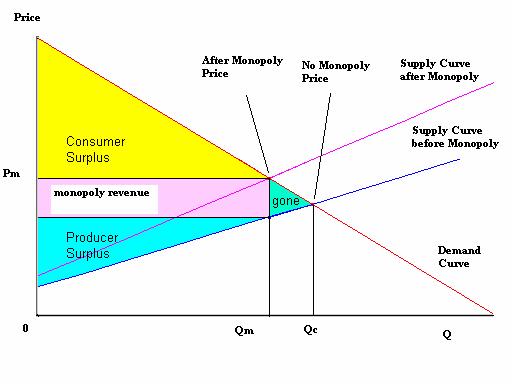

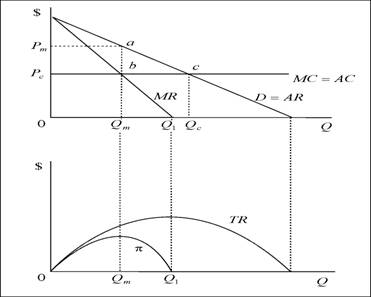
 --------------eq. 1
--------------eq. 1 -----------eq. 2
-----------eq. 2 > 0
> 0 and
and  are the marginal revenue marginal cost of a monopoly respectively.
are the marginal revenue marginal cost of a monopoly respectively. 





